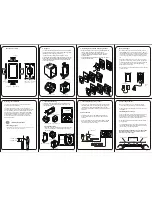
VEEK-MT-SoCKit User Manual
March 17, 2014
18
Chapter 4
VEEK-MT-SoCKit Demonstrations
This chapter gives detailed description of the exclusive demonstrations implemented on FPGA of
VEEK-MT-SoCKit. These demonstrations are specifically developed for VEEK-MT-SoCKit. The
goal is to show the potential of the kit and bring out the unique benefits of FPGA-based SOPC
systems such as reducing BOM costs by integrating powerful graphics and video processing circuits
within the FPGA.
For SoC Linux reference design for touch-screen display, please refer to the document
“Programming Guide for Touch-Screen Display” in the System CD of VEEK-MT-SoCKit.
4
4
.
.
1
1
S
S
y
y
s
s
t
t
e
e
m
m
R
R
e
e
q
q
u
u
i
i
r
r
e
e
m
m
e
e
n
n
t
t
s
s
To run and recompile the demonstrations, you should:
Install Altera Quartus II v13.0 and Nios II EDS v13.0 or later edition on the host computer
Install the USB-Blaster II driver.
Copy the entire folder with demonstrations from the VEEK-MT-SoCKit system CD to the host
computer.
4
4
.
.
2
2
P
P
a
a
i
i
n
n
t
t
e
e
r
r
D
D
e
e
m
m
o
o
n
n
s
s
t
t
r
r
a
a
t
t
i
i
o
o
n
n
This section shows how to control the LCD and the touch controller to run a demo based on Qsys
and Altera VIP Suite. The demonstration also shows how multi-touch gestures and single-touch
coordinates operate.
shows the block diagram of the hardware system for this demonstration. For LCD
display processing, the reference design is developed based on the Video and Image Processing
Suite (VIP) from Altera. The Frame Reader from the VIP is used for reading content to be displayed
from the associated video memory, and the Video Out from the VIP is used to display the content on
the LCD. The display content is filled by Nios II processor according to users’ input.
For multi-touch processing, the Terasic Memory-Mapped IP is used to retrieve user input, including
multi-touch gesture and single-touch resolution. This IP is encrypted, so the license included in the















































